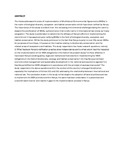| dc.description.abstract | The thesis addresses the state of implementation of Multilateral Environmental Agreements
(MEAs) in the realm of biological diversity, ecosystem and habitat conservation which have
been ratified by Kenya. The importance of the study is evident from the increasing
environmental challenges facing the country despite the proliferation of MEAs, a phenomenon
that is referred to in international law circles as ‘treaty congestion.’The study is undertaken to
determine the efficacy of Kenya’s efforts in implementing the commitment it has assumed upon
ratifying MEAs in the field of biological diversity, ecosystem and habitat conservation. While
the study points out to the fact that Kenya is party to over fifty seven MEAs, for purposes of its
critique, it focuses on the treaties relating to biodiversity conservation and the related areas of
ecosystems and habitats.
The study responds to four basic research questions, namely: (i) What has been Kenya’s
ratification practice since independence and to what extent has this impacted on the
implementation of her MEA obligations in the field of the present study? (ii) How effective in
have been Kenya’s existing policy, legal and institutional frameworks in implementing her MEA
obligations in the field of biodiversity, ecology and habitat conservation? (iii) Has Kenya
prioritized environmental management and sustainable development in her national socioeconomic
agenda? (iv) Has Kenya fulfilled her MEA obligations in accordance with the
principle of pactasuntservanda?
The study responds to the above questions within the context of the country’s changed
Constitution, especially the implications of Article 2(5) and 2(6) addressing the relationship
between international and national law. The conclusion drawn in the study is that despite the
adoption of several policies and law to implement the MEA provisions within Kenya, the same
has been undertaken in a piecemeal and uncoordinated manner and results in gaps in the
implementation process in Kenya. | en |


